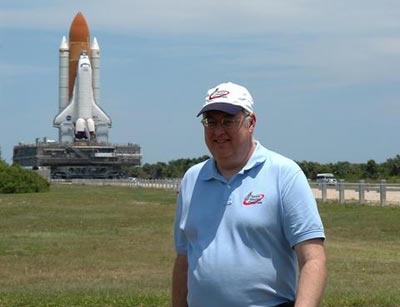Wayne Hale: one of the good guysby Dwayne A. Day
|
| Fixing a culture, though, is not an easy thing to do. Culture consists of the unwritten rules and behaviors that determine how people act, and because they are unwritten, it is hard to identify them. |
During the Columbia accident investigation I was one of over 100 staff members who worked for the CAIB (not all of them worked simultaneously, and for the many months I was there, the staff probably numbered no more than 50–60). There were so many aspects to the investigation that it was impossible to follow them all, and my responsibility was for policy, history, and budget, and later, some of the issues concerning schedule pressure. But I remember one afternoon when I was talking with an Air Force colonel skilled in aircraft accident investigations when Hale’s name came up and I asked how Hale had been involved in the accident. The colonel explained how Hale had been one of the people who had been concerned about the foam strike during the flight and had tried to obtain on-orbit imagery of the orbiter during its mission, only to be rebuffed by upper level managers. Then, after a short pause, the colonel added: “Hale was one of the good guys.”
That’s how many of the staff of the CAIB felt about Hale. The people who met him liked him, even admired him. Some of them even said that he represented the kind of person that we expected from NASA: competent, smart, and thoughtful.
The chairman of the CAIB, Admiral Hal Gehman, had made it clear to the board members and staff that our final report would not focus on individuals, even though there were many outside the investigation who wanted a list of those responsible for the accident so that they could initiate what Gehman referred to as “the ritual beheadings that are a part of every democracy.” Identifying the specific people who had done wrong was left to NASA—and Congress—after our report was done. Gehman’s view was that individuals come and go and what is important is the bureaucracy and culture that they operate within. The culture and the organizational rules had to work in such a way that senior management did not suppress the concerns of lower level operators and engineers like Wayne Hale.
Fixing a culture, though, is not an easy thing to do. Culture consists of the unwritten rules and behaviors that determine how people act, and because they are unwritten, it is hard to identify them. Machines and materials all obey known laws of physics, and even they have proven to be daunting challenges, witness the continued problems with the foam. How can you fix a problem that not everybody sees or understands? We knew that one way to address NASA’s problems was to put good people with the right experience and attitude in key positions, where they could inspire, and lead by example. That seems rather obvious, but identifying “good people” is far harder than one would initially expect. In September 2005 Wayne Hale was promoted to Shuttle Program Manager and several of the former CAIB staffers that I talked to at the time took this as a good sign that NASA was on the right track. Hale had the experience, the attitude, and the reputation for doing the right thing that NASA needed for the shuttle.
| We knew that one way to address NASA’s problems was to put good people with the right experience and attitude in key positions, where they could inspire, and lead by example. That seems rather obvious, but identifying “good people” is far harder than one would initially expect. |
Watching Hale in the press conferences this past week has only reinforced that view. He exudes a natural calm and competence, not to mention honesty. Hale praised his team and discussed the positive developments during the flight. But he also warned against complacency, and has repeated many times one of the findings of the CAIB final report: “this is an experimental vehicle and will be right up until its last flight.” Hale said the same thing after the completion of Discovery’s mission in July, and he will undoubtedly repeat it for every mission from now on.
Admiral Gehman warned his board members and staff that the first few missions after Columbia would be relatively safer because everybody would be on their toes, paranoid, even terrified of making mistakes that could cause another accident. The real test would be seven or eight missions after the initial return to flight, and especially as the program wound down. It was then when workers would get lazy or sloppy. The effect could be extremely subtle, when people stop questioning their assumptions and stop listening to the whispers of the machine. That would be the time of maximum danger.
But watching Hale during the shuttle press conferences gives one reason to hope. He knows how to listen to the machine, and he knows of the importance of listening to people. He’s one of the good guys, and he’s exactly where he should be.
